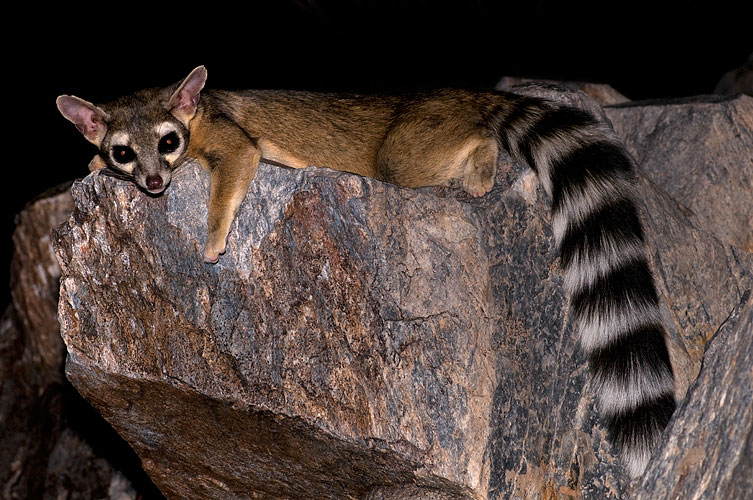What a looker. © Robert Body
The first sentence of this post is quite the confusing conundrum, and as such, you can even find books today that show a "ring-tailed cat" (we'll call it the bassarisk to avoid confusion and so we sound smarter than our friends) such as the one above and declare it synonymous with the cacomistle. And as such, you'll find a picture of a cacomistle declaring it synonymous with the bassarisk.
And this is the cacomistle (Bassariscus sumichrasti). Public domain image.
So what's the difference? Well for the most part it falls within their range.
The cacomistle's range is shown here at the right. In case you don't know your countries, if you're in southern Mexico, Belize, Nicaragua, El Salvador, Honduras, Guatemala, Costa Rica, or the northern tip of Panama, then you've seen a cacomistle. If you find yourself handling one (probably not a good idea if you're in the wild), you'll notice that cacomistles lack retractable claws. Its ears also come to a point and it has a relatively faded tail compared to its northern cousin the bassarisk (I'd like to note here that bassarisk is technically meant to give a common name to both cacomistle and "ring-tailed cat" as the genus they belong to is Bassariscus, but it makes our purpose here easier to explain).
Progressive Commercial Guy says "Gimme one".
And now we come to the range of the ringtai- I mean bassarisk (Bassariscus astutus). The bassarisk is smaller than its southern cousin, obtaining lengths of 33in (tail included) compared to a cacomistle's 39in (this is an American blog and if you want cm then you gotta find an online calculator like I had to to get these lengths). They only overlap in parts of Southern Mexico. Otherwise the bassarisk is found in the rest of the country as well as invading into the US and being found in Texas, Louisiana, Kansas, Oregon, California, Nevada, Arizona, New Mexico, Arkansas, Oklahoma, and Colorado. An impressive list of states for an animal coming from the South, mayhaps being beaten only by nine-banded armadillos in a range for a mammal (no racist jokes here).
The bassarisks won't stand for racism.
Now we've come to the part of the post where you get the lucky chance to learn some pretty neat facts. If you don't think the following are neat, then get off this blog.
Fact one: bassarisks are 85% cookie dough, allowing them to squeeze into tight spaces. This also gives them their cuteness.
The bassarisk is one of the most agile mammals on Earth, with an ankle joint that can rotate over 180 degrees (up there with margays hanging by their paws and tarsiers turning their head in a half circle) and an (obvious) extremely long tail that provides good balance. Like something straight out of The Matrix, they can ricochet off walls to get to a higher point, and they can perform cartwheels and climb up cracks using stemming.
Both cacomistles and "ring-tailed cats" (they're also called ringtails, but there's also a majority of animals called that, if you don't believe me do a cursory search on Wikipedia for "ringtail") can and have been kept as pets, and the latter were used to keep mice away from miners' cabins back during the Gold Rush days. Up with genets and fennec foxes, I think a bassarisk is on my hopeful list for pets. Cacomistles and bassarisks often inhabit old buildings and deserted Native American ruins, probably using them for shelter as our common household cat does with boxes. That's all I got. Next we leave the banded tailed procyonids behind and we cover some South Americans.
If he could wave, this baby cacomistle would be waving bye. ©TheFireTigress on DeviantART.
Sources:
en.wikipedia.org
animaldiversity.ummz.umich.edu
www.desertmuseum.org









No comments:
Post a Comment